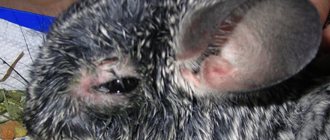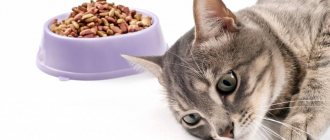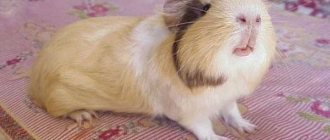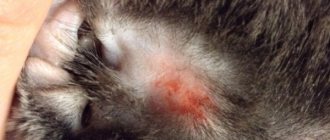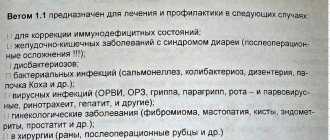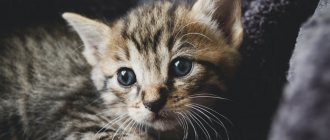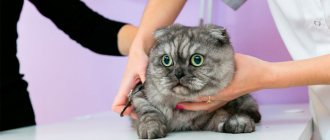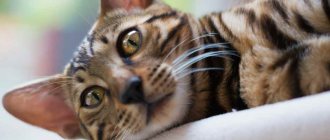11294Administration
Many owners who are faced with this disease are interested in what to feed a cat with urolithiasis at home. There are as many opinions and disagreements as there are people.
The first debate begins with which diet to choose. Indeed, in the modern world there is an innumerable amount of feed and products. In fact, it is not the owner who makes the choice. Only the attending doctor can prescribe what exactly needs to be fed to a cat with urolithiasis.
After examination and tests, the veterinarian will select the appropriate nutrition that will ensure a full life for your four-legged friend.
Each animal is an individual personality. Therefore, each incident requires a meticulous approach and a specialized diet. If a cat has a chronic stage, it will need to be fed with premium food . They will fill the body with vitamins and become a barrier to the formation of new growths.
© shutterstock
Proper and nutritious nutrition for cats with urolithiasis is no joke. The owner will have to be extremely vigilant and diligent. Since dietary feeding will be very strict. Here you will no longer be able to pamper your beloved pet with treats. If you ignore the veterinarian's instructions, unforeseen consequences and even the loss of your four-legged friend may occur.
Types of nutrition for cats and cats with urolithiasis
The diet is prescribed by a veterinarian after conducting the necessary examination and prescribing appropriate therapy. It is not enough for the owner to purchase specialized cat food, because the choice of food should be based on taking into account the characteristics of the course of the disease. In some cases, dry food may be difficult to digest, and natural products require adherence to dosage and individual menu design.
Proper nutrition speeds up recovery
Natural food
The composition of medicinal food for cats with urolithiasis should include vitamins, probiotics, carbohydrates, and proteins. Dietary nutrition requires maintaining a balance between all the necessary components. The menu is compiled individually, taking into account the nature of the pathology, age and weight of the pet.
Everything is prepared only from fresh ingredients, without adding flavorings or salt. Before giving food to the animal, it is cooled to room temperature. The remaining food is thrown away; a fresh dish must be prepared for the next feeding. The diet for the duration of treatment excludes the possibility of pampering the animal with sausage or canned food.
Important! Proper nutrition based on natural food involves controlling the amount of food consumed.
Specialized
Dry food arouses greater interest in the furry patient, which allows the animal owner not to worry about the pet’s satiety.
Dry food makes cats more interested
The advantages of specialized cat food for urolithiasis are:
- economical consumption;
- balanced composition;
- ease of determining the daily dosage.
The transition to this diet occurs within 4 days; every day, a quarter of the normal amount of other food is replaced with medicinal food. With such a diet, you only need to ensure that there is clean water in the animal’s bowl and do not exceed the dose recommended by the manufacturer and veterinarian.
general information
Any cat that repeatedly uses the litter box but is unable to expel a drop of urine needs immediate medical attention.
It has long been noted that pets who constantly eat exclusively dry food have a higher density of urine and tens of times higher content of dissolved substances in it. All this is a critical risk that when exposed to any predisposing factor in your pet's urinary system, crystal deposition will begin. This often happens when a cat is regularly left without fresh drinking water: the density and concentration of urine increases by an order of magnitude. The second accompanying reason is dry food as the only food. When owners often forget to give their pet fresh water, there is a greater than 80% chance that the pet will develop urolithiasis. Thus, feeding cats with urolithiasis is the most important factor that largely determines whether your pet will survive or die.
How do you know if your pet needs to be taken to the vet urgently? Symptoms of ICD are very variable, but there are basic, characteristic signs:
- A sick pet constantly visits the litter box, and the process of urination gradually becomes more and more difficult.
- If the stones are already large enough, or they have managed to get into the urethra, a severe pain reaction develops. The cat wheezes, meows terribly, and seizures similar to epileptic seizures may occur.
- The animal constantly licks the genital area.
- A fairly “standard” symptom of urolithiasis is sudden emptying of the bladder. Simply put, a cat can describe anything, anytime. In this case, there may be a lot of blood in the urine, and the pet, while urinating, will begin to howl and meow hoarsely. It's not a pleasant sight.
Feeding with natural food
Feeding natural food requires a lot of time from the owners. It is necessary not only to develop a suitable diet, but also to regularly buy high-quality products, store them in suitable conditions, and cook them often and little by little.
For example, before putting meat in a purr bowl, you need to keep it in the freezer for 7-10 days, and then defrost it in the refrigerator and pour boiling water over it . It makes no sense to fully describe feeding a cat with urolithiasis natural food: the attending veterinarian will help you choose the right diet.
However, it makes sense to list those foods that are strictly prohibited for animals in a natural diet.
- Fish . River fish contains salts of heavy metals and a large number of parasites. Only absolutely healthy animals can be pampered with sea fish. For urinary tract diseases, fish is a source of magnesium and phosphorus, which settle in the bladder, forming struvite stones.
- Milk . This product is not always digestible by animals, and in the case of ICD it can cause serious harm, because it contains at least 0.12 mg of magnesium with the maximum allowable amount for a furry pet being 0.10 mg.
- Pork
- Oatmeal
- Hot, smoked, spicy, salty products of any origin
The most common types of uroliths (kidney stones)
Struvites are salt deposits in the form of rounded stones from light yellow to amber in color. In medical terms, these are trivalent phosphates that precipitate due to excessive consumption of magnesium and phosphorus. As you can guess, excessive consumption of fish (or unbalanced dry food), sedentary lifestyle, genetic predisposition = 80% chance of developing struvite.
Oxalates (calcium oxalates) are salts of oxalic acid in the form of creamy and dark yellow formations of irregular shape. Unlike struvite, the surface of oxalates is riddled with tubercles, depressions and protrusions, which, when passing through the urethra, form wounds and ulcers on its walls, which makes the process of urination so painful.
The main prerequisite for the appearance of oxalates is “acidification” of urine. This phenomenon does not suddenly occur, but develops over years if your pet’s food is high in acidity and low in calcium. If the animal has not consumed enough liquid, its urine turns into a real solution of concentrated oxalic acid.
Ammonium urates are the least common, they look like star-shaped brown crystals. Due to the extremely heterogeneous surface, they can not only clog the urethra, but also severely injure the walls of the urinary tract. For this reason, not just inclusions, but real blood clots can be found in an animal’s urine. One of the reasons for the occurrence of urates may be a lack of natural GAG inhibitors in the diet.
Selection of food for urolithiasis
When prescribing a diet, it is not enough for a veterinarian to identify the presence of urolithiasis. It is necessary to establish whether the pathology occurs in an acute form or whether its chronic form has worsened. Attention is also paid to the individual characteristics of the animal, including its taste preferences.
Nature of stones
Cystitis in a cat: symptoms and treatment at home
Oxolate stones and struvite can form in the urinary system of cats. Prescribing dietary nutrition, taking into account the characteristics of the formation of formations, can speed up the healing process and prevent the worsening of the pathology.
Excess oxalic acid and calcium lead to the appearance of oxalate stones, so nutrition during the treatment period should be aimed at increasing the alkaline index of urine. All foods with calcium are excluded from the animal’s daily diet, and the amount of carbohydrates and fats consumed is reduced as much as possible.
Important! The menu must include foods rich in sodium and protein, but even these must be strictly dosed.
The following products are prohibited for pets:
- flour products and even bread;
- raw fish;
- milk products;
- liver;
- eggs.
It is not recommended for a cat to cook porridge, with the exception of rolled oats, but not more than 2 times a week. It is useful to include boiled fish and meat in the diet; you can also give broths. When choosing meat or fish products, preference is given to low-fat varieties. The basis of nutrition for this type of stones is vegetables.
During the period of getting rid of oxalate stones, specialized foods can also be used. In the popularity rating for prescriptions by veterinarians, the first places belong to:
- Hills Prescription Diet Feline.
- Eukanuba Oxakate Urinary Formula.
The ingredients in these foods prevent the formation of new formations and create an environment conducive to the dissolution and subsequent painless removal of existing stones.
Against the background of an infectious disease, struvite may form in a cat. In this case, the acidity of the urine should be increased. The daily menu should contain only foods low in protein, phosphorus, calcium and magnesium.
Dairy products are banned
The basis of natural nutrition consists of dishes from the following products:
- boiled beef or liver;
- rice;
- cabbage and carrots;
- a small amount of lean fish, steamed.
It is easier to combat struvite when switching the animal to medicated dry food. The Hills brand produces formulations that help prevent the development of the disease and ensure the removal of already formed crystals.
Dosage
When using a diet based on natural food, the daily intake of all necessary vitamins, microelements, proteins, fats and carbohydrates is given in portions so that the food does not linger in the bowl, because the animal needs to eat only fresh and warm food.
It is easier to calculate the required amount of nutrients in food when using dry food. The manufacturer has already balanced everything when creating cat food and even made a simple dosage recommendation.
For animals that are not inclined to be greedy, the entire daily allowance is poured into a bowl once a day so that the pet can come up and eat during the day. If dry food causes the cat to forget about control, then replenishing the bowl should be done in small portions throughout the day, with great attention paid to following the recommendations regarding the daily dosage.
Important! Overeating or obesity can aggravate the course of the pathology, therefore, for castrated and very well-fed animals, it is recommended to slightly reduce the daily dose of specialized food.
The influence of nutrition on the development of pathology
| Types of stones formed in the kidneys and bladder | Description | Photo |
| Struvite (triple phosphates) | The composition of crystalline formations includes magnesium, ammonium and phosphate salts. Often stones occur due to an inflammatory or infectious process. They respond well to drug treatment and are responsive to changes in diet | |
| Oxalates | Crystalline formations of irregular shape. Calcium reacts with oxalic acid to form oxalates. The main reason for their synthesis is an excess of calcium and oxalic acid in the pet’s body. | |
| Calcium phosphates | Just like oxalates, these types of stones are insoluble compounds that are formed, among other things, when the diet is unbalanced in minerals. The pathology is difficult to treat; surgical removal of uroliths is more often used | |
| Cystines and ammonium urates | Formed from cystine and uric acid due to unbalanced nutrition, inflammatory processes of the genitourinary system |
Experts have long noticed that one of the reasons for the development of urolithiasis is an error in the diet of cats. Normally, all salts that are excreted through the kidneys are in soluble form. If the diet is violated, some salts of organic acids, for example, urea, precipitate in the form of crystalline sand. Sand, which is based on uric acid, compacts over time and turns into uroliths, which is the direct cause of urolithiasis (UCD).
The acidity of urine has a great influence on the formation of stones. Normally, a cat is sour. Alkalinization or strong acidification of urine leads to intensive synthesis of uroliths in the kidneys and bladder. A high-protein diet alters the normal metabolism of protein in the body, which leads to acidification of urine, an increase in the concentration of uric acid and the formation of stones in the kidneys and bladder. A diet poor in vitamins A and B1 leads to urine acidification. This phenomenon occurs when feeding a cat only fish or only meat. Therefore, in no case should you feed a cat with ICD exclusively the same type of food.
The formation of uroliths is influenced not only by acidification, but also by alkalization of urine. This is caused by constant feeding of the animal with fish and fish waste, and meat.
The processes of stone formation in the urinary system of domestic cats are very complex and depend on many factors. Proper nutrition, closest to the physiological needs of a domestic cat, is one of the main priorities in the treatment and prevention of urolithiasis.
We recommend reading the article about why a cat's urine stinks. From it you will learn about the causes of the pungent odor, the actions of the owners when identifying this symptom, nutritional correction, and methods of getting rid of the unpleasant odor.
Symptoms
The main sign of the appearance of struvite in a cat’s urine is problems with urination. It is difficult, due to constant irritation of the urethral mucosa, urinary incontinence develops (the cat often sits on the tray or urinates anywhere) or stranguria (painful urination, which is evidenced by the unnatural tense posture of the animal when sitting on the tray).
With the further development of urolithiasis, the cat loses its appetite, often drinks water, and a deterioration in its general condition can also be manifested by rapid breathing and heartbeat. The urine becomes cloudy and may contain sand or blood. If a stone clogs the ureter and urine is not excreted from the body for more than a day, toxins begin to accumulate in the animal’s blood, causing poisoning of the body. Without urgent help, the cat will die from a ruptured bladder or acute renal failure.
Important! If the ureter is obstructed (blocked) by a stone, you should not try to expel it by giving the cat a diuretic. The result may be damage to the urinary ducts or rupture of the bladder.
"Home kitchen"
In general, quite a lot of feed similar to those described above are produced today. They are great for daily feeding of sick pets... but their cost and low availability (they are not available in all pet stores) scares off many breeders. What if for some reason you cannot purchase commercial varieties of food suitable for cats with ICD? You'll have to make do on your own.
First, a little theoretical biochemistry. The owner’s main task is to increase the volume of daily urine production, but at the same time reduce its concentration. Even if there are factors in the animal’s body that contribute to the deposition of crystals, under such conditions the process will proceed disproportionately slower. Secondly, it is imperative to achieve alkalinization of urine.
The most difficult task is to limit the daily intake of protein, despite the fact that the cat’s body still needs it. N-(2-mercaptopropionyl)-glycine, as well as penicillamine, have proven themselves to be good in solving this problem. The first reduces the absorption of certain protein compounds, the second significantly reduces the amount of microelements assimilated.
Firstly, long-term use of these drugs is fraught with severe vitamin deficiency and exhaustion. Secondly, about 40% of animals generally react to their intake with severe vomiting. To prevent vitamin deficiency, replacement therapy must be carried out. For this purpose, the animal is prescribed Gamavit or a similar medicine.
Some veterinarians believe that the problem of vomiting can be solved by giving medications mixed with some fat. Such a diet for urolithiasis in cats, among other things, can stimulate the development of appetite in a sick pet.
Foods that should be excluded from the diet
Diarrhea in a cat: how to treat it at home
Regardless of what type of stones are found in the animal, amendments are made to its daily menu to exclude the intake of sausages, large amounts of salt and calcium. When preparing a diet, the veterinarian needs to know not only what a cat is fed with urolithiasis, but also the patient’s taste preferences. After all, switching a lover of natural products to dry food or vice versa during a period of illness is difficult and dangerous due to the development of a stressful state in the animal. Therapeutic nutrition is selected individually, but there are foods that are necessarily prohibited until recovery.
Cottage cheese
It is necessary to avoid dishes based on cottage cheese due to the high content of calcium in its composition, which can be quickly absorbed. Including this product in the diet accelerates the growth of new stones.
Eggs
The yolk contains high concentrations of calcium compounds, so the cat will have to stop eating eggs during treatment.
The cat will also have to stop eating eggs.
Dairy products
Milk, cheeses and numerous fermented milk products are rich in calcium, which should be reduced rather than increased in accordance with dietary requirements. When consuming milk or cream in adult and elderly animals, the condition may be aggravated by the development of indigestion, which is associated with an imbalance of enzymes under the influence of age-related changes.
What to feed a sick pet?
All commercial cat foods contain beneficial minerals, proteins and water. The problem is that not all manufacturers produce truly high-quality products that meet the requirements described above. But not everything is so hopeless. We will describe some medicinal foods that even experienced veterinarians prescribe for cats with urolithiasis.
The quality of nutrition of a cat cured of urolithiasis is the key to its future health. A lack of nutrients, microelements and vitamins weakens the immune system: it will be unable to cope with negative environmental factors, and secondary infections may develop. URINARY S/O LP34 is designed to prevent this.
It contains a moderate amount of minerals: although in large quantities they are harmful to an animal with urolithiasis, its body needs building materials to maintain bone tissue and teeth. If there are few of them, the cat is guaranteed to develop osteodystrophy. On the contrary, with a high content of calcium and magnesium in food, he is guaranteed to get a complication of urolithiasis.
In addition, the diet food is designed to be easy for sick cats to chew. Its pieces are small, but at the same time their density is selected so that the pet’s jaw apparatus is not overloaded. The rigidity is sufficient for natural cleaning of the jaws, which ensures the absence of tartar and plaque.
Royal Canine Renal
This food is also aimed at maximizing the health of a pet who is recovering or still suffering from urolithiasis. If your pet does not have enough nutrients, microelements and vitamins, his body will not be able to recover normally. But their excess is no less evil. In this case, the pathology will only worsen.
The food is recommended for daily feeding of sick cats, but is especially recommended for giving to young pets (and they can also suffer from urolithiasis). It is perfectly absorbed by the animal’s body even in cases where the disease is complicated by some problems with the gastrointestinal tract. The product is produced both in the form of a dry fraction and in the form of a light mousse that does not overload the chewing muscles and jaw apparatus of the pet. In addition, it contains a balanced amount of calcium and oxalic acid.
The main problem when feeding a pet with urolithiasis is that, due to its unimportant condition, it simply does not want to eat. Royal Canine Renal has been formulated to stimulate animals' instinctive feeding interests by containing a perfectly balanced combination of flavoring agents.
Natural nutrition
An animal that eats natural food should not eat any sausages.
- Smoked foods, sausages, canned food and other delicacies are completely excluded from the daily diet of a sick cat.
- If you have urolithiasis, any sweets are prohibited.
- If urates, oxalates or struvites are detected in a cat, then give lean meat, which is pre-boiled.
- Fish is allowed in the animal’s diet, but only low-fat and boiled.
- It is strictly forbidden to add salt to food or add sugar, even in small quantities.
When a cat has urological syndrome, it is recommended to strictly adhere to the diet and feed the pet the following foods:
- Hercules and rice porridge.
- Boiled and raw vegetables: carrots;
- beet;
- broccoli;
- cauliflower;
- pumpkin;
- potatoes and others.
Feeding with natural food
This type of nutrition requires considerable effort and attention from the owner. Therefore, it is much easier to use ready-made food.
But if you still decide to feed your pet natural products, then the owner must adhere to the diet prescribed by the doctor in accordance with the type of stones.
When feeding natural food:
- You cannot use feed and natural food at the same time.
- It is forbidden to give only proteins.
- It is necessary to introduce porridge and vegetables into the diet.
- Be sure to monitor your cat’s gastrointestinal tract.
- Vitamins must be given.
It is important to establish a sick cat’s diet and offer him enough clean water. It is necessary to ensure that the animal does not overeat.
Diet
When creating a menu, it is not recommended to completely exclude natural products. They are a source of vitamins and help normalize the digestive system.
Lean meats
What to feed a kitten: diet for different ages
Turkey, rabbit and chicken can be given to your cat raw, provided there are no bones or fat in the meat (it is recommended to give preference to fillet). Beef and pork are included in the animal’s diet only when well boiled. The broth left over after cooking meat can be given to the cat in its pure form or used for making soups.
Important! Meat for feeding a furry patient should be fresh and lean. No salt or spices are added to it during the cooking process.
Vegetables with minimal alkali content
It is recommended to give your cat fresh pumpkin and zucchini in small quantities; British and Siberian cats also include fresh cucumbers in their diet. It is beneficial for animals to prepare soups based on carrots or cabbage.
Preventive recommendations
To prevent the formation of tripel phosphates in a cat’s urine, the following conditions must be met:
- Monitor water quality. If tap water is of unsatisfactory quality, use bottled water.
- Use nutritionally balanced feed mixtures of at least premium class or natural feed of similar quality.
- Neutered cats should be fed only prepared food intended for sterilized cats.
- Deworm and vaccinate pets as recommended by your veterinarian.
If you suspect that you have urolithiasis, you should not use the medications at hand, folk remedies, or the advice of smart people.
Rating of cat food manufacturers for urolithiasis
Specialized food for sick pets differs in composition, which provides a specific taste and smell that repels picky cats. The cost of such food also differs, forcing some owners to focus on price rather than the pet’s taste preferences.
Royal Canin
For urolithiasis, veterinarians recommend super-premium dry food of this brand for cats:
- Royal Canin Renal. The composition contains rice powder, animal and fish oils, sunflower seeds, soybean oil. Switching to this form of food is not recommended if you have kidney pathologies. The cost of packaging 0.5 kg is from 520 rubles.
- Royal Canin Urinary. It is made on the basis of rice, wheat and corn flour, and additionally contains processed by-products and poultry meat. The consumption of such food ensures the breakdown of oxalate formations and struvite, and also prevents the formation of new stones. This food can be given to animals constantly; disruptions in the functioning of the cardiovascular system are considered a contraindication. The cost of a 3.5 kg package starts from 2,700 rubles.
Important! When switching to food from this manufacturer, it is necessary to take into account that its constant use in some animals provokes a pronounced decrease in the concentration of potassium in the blood, so it is recommended to regularly donate blood for analysis in order to monitor the pet’s condition.
Hills
Depending on the severity of the patient’s condition, this therapeutic nutrition is recommended for him for 1-13 months. The food is selected taking into account the nature of the disease and the type of stones:
- Hill's Prescription Diet c\d. It is based on starch and corn flour, rice in crushed form. Additionally, the composition includes a complex of vitamins and microelements, meat and chicken oil. This food is prescribed after removal of struvite stones for 1.5-3.5 months in order to prevent relapse. The diet is contraindicated for pregnant cats and kittens under 1 year of age. The cost of a package weighing 400 g is from 350 rubles.
- Hill's Prescription Diet s\d. This food based on fish meal, a complex of vitamins, antioxidants and taurine is recommended for dissolving struvite stones over 3-4 months. Chicken and turkey are included as meat components. If oxalate stones are detected, such nutrition is contraindicated. A 1.5 kg package has a price starting from 1350 rubles.
- Hill's Prescription Diet k/d. Contains plant proteins, grains and processed meats. The food is recommended to alleviate the condition of kidney pathologies, but is contraindicated in animals with impaired liver function. Suitable for permanent use. Cost 1.5 kg from 1300 rubles.
- Hill's Prescription Diet Metabolic + Urinary Feline. It has a rich composition, is effective for the treatment and disease of pathologies of the urinary system, normalizes metabolism, has no contraindications, and is suitable for continuous use. A 1.5 kg package costs from 1,300 rubles. Recommended for cats that have had to be neutered.
- Hills Prescription Diet Feline. The composition is selected in such a way as to ensure the dissolution of oxalates. The feed is used for 3-7 months. A contraindication is the detection of struvites. The cost of packaging 1.5 kg is from 1450 rubles.
Important! The listed foods are produced in dry form and belong to the super-premium class.
And others
Purina Veterinary Diets UR Urinary Feline has good reviews, but when switching to this food, you must take into account that the animal may require parallel intake of probiotics to normalize the functioning of the digestive system. A 1.5 kg package costing from 1,100 rubles is sufficient for a course of treatment. Contains rice and corn flour, a complex of vitamins, and yeast.
Farmina Vet Life Cat Struvite can be used to treat struvite. A special feature of this food is the inclusion of potassium, which reduces the risk of developing concomitant diseases. Medical nutrition is used for 2-6 months, the cost of a 2 kg package is from 1450 rubles.
For the prevention of pathologies of the urinary system and recovery after illness, the use of Cat Chow Urinary Tract Health is allowed. The composition contains vegetables, yeast, grains, processed fish, poultry and meat. Suitable for regular use, the advantage is the cost: a 2 kg package has a price of 600 rubles.
Characteristics of the “medicinal” diet
Let us warn you that feeding cats with urolithiasis is an extremely difficult matter, and you are unlikely to be able to choose the correct ratio of nutrients and microelements on your own. Judge for yourself:
- It is necessary to provide the cat with exactly the right amount of protein so that it completely covers the pet’s needs, but nothing more. At the slightest excess of this amount, excess protein compounds will quickly begin to precipitate, worsening the already not ideal condition of the pet.
- It is necessary to lower the urine pH to a level of approximately 6.5-7, since under these conditions the formation of new uroliths is difficult, and old ones begin to tend to dissolve.
- The feed should contain potassium citrate to maintain a balance of calcium oxalate in the urine.
- It is imperative that the food for a sick pet contains a sufficient amount of moisture, since otherwise the density and concentration of urine will constantly increase, which is completely unnecessary in case of urolithiasis.
Tripelphosphates in cat urine: what does it mean?
Tripelphosphates are detected by crystallographic analysis of urine. The crystals are shaped like a coffin lid. They are often found by chance, before signs of urolithiasis appear.
Cats get sick if the following circumstances predispose them:
- congenital predisposition;
- hypovitaminosis A;
- hormonal imbalances;
- infectious diseases
- adynamia;
- obesity.
Lack of physical activity occurs in pets living in high-rise apartments. Most often, owners castrate their cats.
Lack of motivation to move contributes to excess weight gain. Specialized food for sterilized animals is a lifesaver, since it contains a large amount of dietary fiber, which limits feed consumption.
Required amount of water for urolithiasis
Lack of water aggravates the course of the disease, so no matter what type of food is used, the animal should always have access to clean drinking water in its bowl. During treatment, the owner must make it a rule to change the bowl of water at least 2 times a day so that the liquid remains clean.
It is recommended to refuse tap water; give it to a sick animal only after boiling or filtering
Important! It is recommended to avoid tap water. A sick animal is given only liquids after boiling or filtering.
A special diet during treatment for urolithiasis helps your pet recover faster. The disease will not become chronic and will not cause complications if you follow the veterinarian’s recommendations.
Once again about protein
All renal diets should provide potassium in addition to being low in protein, but should be lower in calcium, sodium and phosphorus. Experienced veterinarians, in addition, advise adding Omega-3 fatty acids and vitamins to food. But these relationships are not so simple.
About five years ago, French veterinarians proved that in some cases a cat requires at least 45% protein based on the dry matter of food. The data is not final. But research by German and domestic veterinarians has clearly proven that cats over 12 years old, even if they are sick with urolithiasis... require more protein and microelements, since their body, in principle, absorbs them worse.
And further. Throughout treatment, perform a simple check on your pet at least once a week. To do this, you need to try to grab it by the spine with two fingers (index and thumb) in the space between the ribs and the sacral region. This is unlikely to be possible in animals with normal muscle mass.
But if you manage to easily grab the cat by the spine, and his muscles feel somehow “decrepit” and “vague” to the touch, you need to urgently adjust the diet. Such signs clearly indicate a severe lack of protein in food. If you don't give your pet more protein, things can end badly. It may be necessary to give up “amateur activities.” It would be better to use veterinary food that is precisely balanced and contains everything you need.
Diagnostics: how to identify pathology
It is important to quickly identify the problem so that you can deal with it and save the life and health of your four-legged friend. To do this, at the slightest suspicion of genitourinary problems, you need to take your pet to a veterinary clinic. The specialist will ask you to describe the cat’s behavior in detail, and then prescribe the necessary studies.
Unfavorable changes can be identified using x-rays, ultrasound, and also by studying the sediment of the discharge in the laboratory and determining the type of salt formation. The composition of the crystal will allow you to understand what kind of prevention and therapy needs to be carried out. The clear presence of salts is determined by qualitative analysis methods: light microscopy, Xray diffraction, etc. The specialist will also prescribe a blood test.
At the appointment, you need to accurately and in detail tell about all the details of keeping the pet, its physical condition, diseases, when the first signs of deviations began to be observed, etc.
